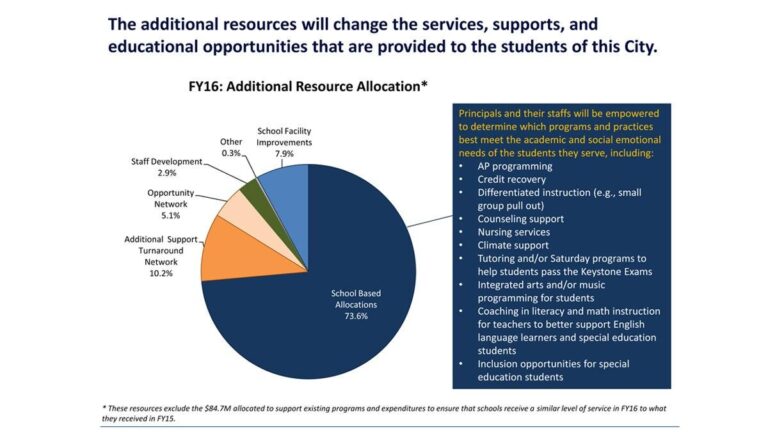Strengthening Philadelphia’s Public Schools Through Enhanced City Funding
Philadelphia’s education advocates are intensifying their appeals for the municipal government to substantially increase financial support for public schools. They highlight alarming budget deficits that jeopardize the quality and fairness of education across the district. While state and federal contributions remain vital, community leaders stress that these sources alone cannot cover escalating operational expenses or critical programmatic needs. Without a significant boost in city funding, disparities in resources, teacher retention, and student services are expected to widen.
Calls for increased city investment also emphasize the necessity for transparent budgeting and responsible fund management. Advocates argue that prioritizing expenditures on modern technology, mental health initiatives, and facility upgrades is essential to foster safe, nurturing learning environments. Key proposals include:
- Broadening access to after-school enrichment and academic support programs
- Investing in ongoing professional training for educators
- Addressing deferred maintenance and infrastructure modernization
| Funding Source | Annual Allocation | Primary Use |
|---|---|---|
| State Funding | $650M | Core Operational Costs |
| Federal Grants | $180M | Specialized Programs |
| City Budget | $95M | Capital Projects & Improvements |
Consequences of Funding Deficits on Students and Educators
Ongoing financial shortfalls have severely impacted both student resources and teacher retention rates, creating a challenging atmosphere within Philadelphia‚Äôs public schools. Budget constraints have led to the elimination or reduction of vital programs such as arts education, extracurricular activities, and mental health support‚ÄĒelements crucial for holistic student growth. Many students now contend with overcrowded classrooms and outdated instructional materials, which impede their academic achievement and engagement.
Moreover, insufficient funding has taken a toll on teacher morale and stability. Educators frequently report feeling undervalued and overwhelmed, with compensation that does not align with Philadelphia’s rising living costs. This has resulted in a high turnover rate, as many teachers seek employment in districts offering better pay and working conditions, disrupting continuity and weakening school communities. Notable challenges include:
- Increased responsibilities due to understaffing
- Scarce opportunities for professional growth
- Limited resources to support innovative teaching methods
| Area Affected | Outcome | Data Highlights |
|---|---|---|
| Student Programs | Significant Reductions | 40% decrease in extracurricular activities |
| Classroom Size | Overcrowding | Average exceeds 30 students per class |
| Teacher Stability | High Attrition | Annual turnover rate at 25% |
Equitable Distribution Strategies for City Education Funding
Philadelphia’s education advocates propose a comprehensive framework to ensure city funds are allocated more equitably, especially targeting schools in historically underserved neighborhoods. Their recommendations include:
- Implementing weighted funding models that direct additional resources to schools with higher populations of low-income, special education, and English language learner students.
- Establishing community-led budget committees that engage parents, teachers, and local stakeholders in fiscal decision-making.
- Developing transparent financial reporting systems accessible to the public to enhance accountability.
These measures aim to narrow funding disparities and promote fairness throughout Philadelphia’s diverse school districts. The table below illustrates proposed funding weights based on student demographics:
| Student Category | Funding Multiplier | Justification |
|---|---|---|
| Low-income Students | 1.5x base amount | Addresses additional support requirements |
| English Language Learners | 1.3x base amount | Supports language acquisition efforts |
| Students with Disabilities | 2.0x base amount | Ensures adequate special education resources |
| General Student Population | 1.0x base amount | Standard funding allocation |
Fostering Collaboration for Sustainable Education Funding
Community leaders in Philadelphia are advocating for a cooperative partnership between city officials and school administrators to secure long-term, stable funding for public education. They emphasize that consistent financial support‚ÄĒnot short-term fixes‚ÄĒis essential to improve school infrastructure, technology access, and extracurricular programming. This collaborative approach is seen as vital to closing persistent gaps and enhancing student outcomes.
Key priorities for this partnership include:
- Creating a clear and transparent framework for fund distribution
- Forming joint oversight committees to monitor spending and ensure accountability
- Allocating resources toward mental health services and community-based initiatives
- Hosting regular forums to gather input from educators, families, and students
| Focus Area | Current Funding | Requested Increase |
|---|---|---|
| School Facilities | $45M | $70M |
| Student Support Services | $20M | $35M |
| Technology & Digital Equity | $15M | $30M |
Conclusion: The Path Forward for Philadelphia Education
As advocates in Philadelphia continue to press for increased municipal funding, the dialogue surrounding equitable resource distribution remains a pressing concern. The collective voices of educators, parents, and community leaders underscore the urgent need for enhanced city investment to rectify long-standing inequities within the public school system. The decisions made by policymakers in the near future will be instrumental in shaping the educational landscape and opportunities for Philadelphia’s students for years to come.








